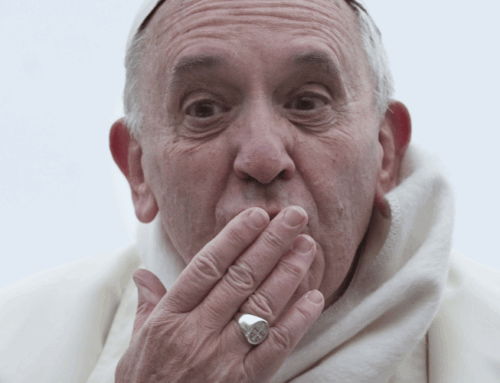Therefore I tell you, do not be anxious about your life, what you shall eat, nor about your body, what you shall put on. For life is more than food, and the body more than clothing. Consider the ravens: They neither sow nor reap, they have neither storehouse nor barn, and yet God feeds them. Of how much more value are you than the birds! And which of you by being anxious can add a cubit to his span of life? If then you are not able to do as small a thing as that, why are you anxious about the rest?”
Wonderful words from the Gospel of Luke—I’ve recalled them often in times of worry, both great and trivial. But can we possibly live without anxiety?
Anxiety is the body’s built-in response to perceived danger—the brain’s “fight or flight response.” But sometimes our bodies respond as if we are in danger when, in reality, we are not. For someone suffering from anxiety, the body’s reaction is out of proportion. Even small annoyances might be perceived as physical threats. Heart rate increases; we sweat and tremble; we can’t focus or concentrate on anything else. We run or we fight. And we get depressed. Anxiety disorders and depression go hand in hand.
Mindfulness has gotten a lot of attention recently—even making the cover of Time Magazine. It’s being lauded as a practical approach to coping with daily anxiety and an effective treatment for clinical diagnoses of anxiety and depression. On 60 Minutes, Anderson Cooper interviewed one of the men most responsible for popularizing mindfulness, Jon Kabat-Zinn, Professor of Medicine Emeritus and creator of the Stress Reduction Clinic and the Center for Mindfulness in Medicine, Health Care, and Society at the University of Massachusetts Medical School.
Kabat-Zinn, whose best-selling books include the landmark work on mindfulness and healing, Full-Catastrophe Living, has been researching the effects of mindfulness on the brain over the past twenty years. As a result of his rigorous work, and the work of others, we now can see how the practice of mindfulness can change the brain at a chemical level, and ultimately even change the anatomy of the brain, to reduce the symptoms of anxiety and depression.
Jon Kabat-Zinn is also a Buddhist, and he brought mindfulness to UMASS in the way he understood it—as an element of Buddhist philosophy. There is nothing fundamentally problematic with this, however the Buddhist background and vaguely spiritual language triggers skepticism for people of faith who are weary of trendy new-age movements.
The simplest definition of Mindfulness is “non-judgmental awareness of the present moment.”
The fact of the matter is that mindfulness is not inherently spiritual. Mindfulness does involve consciousness, so it is invisible, but it is not spiritual. Actually, Buddhism is not so much spirituality as it is a philosophy of life. When people asked Buddha what he was teaching, he said he taught “the way things are.” He said nobody should believe his teachings out of faith, but instead they should examine for themselves to see if they are true or not. Even if mindfulness was originally a Buddhist practice (it isn’t, as I will explain below), we can simply evaluate it like anything else to see how well it lines up with truth.
Think of mindfulness practice as brain exercise, not unlike Sodoku or a crossword puzzle, that activates neural stimulation in certain parts of the brain, and in doing so, creates stronger neural pathways and connections. Research shows that mindfulness stimulates parts of the brain that help people to feel less anxious, and turns off the parts that make people feel more anxious. It can help us regulate our “fight or flight” response and regain control of our bodies.
It is good to seek peace and freedom from anxiety. But is mindfulness truly the way to peace? As a Catholic psychologist, I believe that without grounding mindfulness practice in a “true anthropology”—the true nature of the human person—there will always be something missing.
A “true anthropology” understands that human beings are a union of body and spirit made for eternal union with God, who is the True, Good, and Beautiful. As we make decisions and act in ways that are in accord with the True, Good, and Beautiful, we are transformed by those acts and move closer to our destiny. This is true human flourishing.
But we can make better choices when we understand ourselves better, and this includes understanding our bodies. Before getting back to mindfulness, we need to unpack what anxiety is and why we feel it.
Like most animals, God created us with a “survival instinct” and deep principles of self-preservation. St. John Paul II described these faculties of the human person in his philosophical work titled The Acting Person. He used the labels “somato-vegetative” and “psycho-emotive” to describe the parts of the person that respond to external stimuli in ways that preserve our life and well-being.
Instead of paying attention to the fantasies we create in our imagination, we pay attention to the reality that is occurring outside our mind.
God made our brains to sense physical danger and respond accordingly. When danger is presented to our senses, something called the “sympathetic nervous response” is activated—the “fight or flight” response. Our brains initiate a series of electrochemical reactions that ultimately increase our heart rate, constrict muscles, tighten the chest, dilate our pupils, raises our blood pressure and consequently increases sweating and our ability to focus (on the perceived danger). This comes in very handy when we need to run from some danger or fight for our lives. Sometimes this leads to seemingly superhuman strength, like the mother who can lift a car off of a pinned child.
Typically we think of having five senses. When we see, hear, smell, touch, or taste something dangerous, our bodies react in this “sympathetic” way. However, there is actually a sixth sense that also initiates the sympathetic response. We might call this our “intero sense.” This is the sensation we have of occurrences within our body. Scientists are a little behind in exploring and understanding exactly what the intero sense can do, but one thing we know is that the sympathetic nervous system can respond to it. This is why we have all the classic fight or flight responses when having a nightmare. Even though there isn’t a real danger present to our five external senses, our brains still interpret the presence of a danger and react accordingly.
Put simply, our brain’s danger response system has the ability to activate when there is actually no danger. Do you see how this might become a problem?
Let’s jump back to anthropology for a minute and talk about imagination. Imagination, according to St. John Paul II, is a capacity that God gave us to create ways of beautifully mirroring something about our Creator. The ideas we imagine—or create—are really new creations. They have being, they are things that exist, and they didn’t exist before we imagined them. These ideas can either match up to objective reality or not, but either way the thought itself is a new creation. (You can have the thought “the sky is blue” and you can have the thought “the sky is green.” Both are thoughts—they are things that exist—but one lines up to truth while the other doesn’t).
Ultimately our imaginations allow us to encounter spiritual realities that exist beyond the material world, without which we would be limited to perception by our five external senses. This is a really wonderful way to think about imagination and the creative ability of the mind. However, it also provides a strong foundation from which to understand certain disorders of the mind.
When our brains create thoughts that we perceive to be dangerous, it can cause our intero sense to activate our sympathetic nervous system. Our body then responds as if we’re in physical danger, even though we’re not. This, in basic terms, is the source of anxiety. Interestingly it is also the basis for depression. There is a physiological connection between the two. For people suffering from these disorders, extreme depression can turn into anxiety, and extreme anxiety often becomes depression.
It’s not only physically dangerous situations conjured up by our minds that can trigger our nervous system to respond—any kind of problem can. When we are in danger, point A is where we are now and point B is where we need to go for safety. The sympathetic nervous response is our body’s way of propelling us away from danger and towards safety. Any time we judge that where we are now (Point A) is not where we need to be to feel safe (Point B), we experience anxiety.
The practice of mindfulness can change the chemistry and anatomy of the brain, and reduce the symptoms of anxiety and depression.
With this background we can turn back to what mindfulness is. The simplest definition of mindfulness is “non-judgmental awareness of the present moment.” When we are aware of what is going on in the present moment, especially through our five senses that tell us about the real world happening now, and there is no immediate danger to threaten us in that present moment, our brains react and set into motion the electrochemical reactions that do the opposite of the sympathetic nervous response. Our pupils return to normal, our heart rate decreases, blood pressure decreases, and our mind broadens its focus to take in everything going on around us instead of focusing on one point. This is assuming of course that there is not some real danger. If the building is actually on fire and your sense of smell perceives smoke, your brain will go into fight or flight mode. But when the building is not actually on fire, we are better served when our brains aren’t acting as if it were.
The practice of mindfulness is simply learning how to control our focus so that instead of paying attention to the fantasies we create in our imagination, we pay attention to the reality that is occurring outside of the space between our two ears. Mindfulness means “coming to our senses.” It is a way of plugging ourselves into reality instead of letting the creations of our minds dictate what we pay attention to.
This is not easy for us. The human mind is subject to a sneaky deception that says: “If I pay attention to my problems, I can somehow figure them out.” As a result, we tend to obsess about problems with tenacious dedication.
Imagine being stuck in traffic and thinking about the meeting you are missing. There might be one or two things you can do to make your situation better. But let’s assume you don’t have a cellphone, you can’t call to let anyone know you’re going to be late, and there’s no way to get out of traffic. Most of us will still spend that time focusing on the swirl of thoughts in our mind that play out all the horrible consequences of our tardiness. There is a sense that if we figure out all the angles, we’ll be ahead of the game. We usually have no idea that we’re even spending this precious time caught in the tornado of our own thoughts. This can happen even when we aren’t stuck in traffic. We arrive at our destination surprised that we’re already there, and without remembering any of the stoplights or stop signs along the way. We trust our “autopilot” to do the driving while our minds are focused on seemingly more important things—a mistake we made yesterday, a family conflict, or some difficulty waiting for us.
What we’re doing is creating problems in our mind that need to be solved—problems that are “dangerous” to our brains. They aren’t physically dangerous, like being in a burning building, but our brains only know what we tell them. They then activate the sympathetic nervous response and we experience anxiety symptoms.
Once we are aware that this process is taking place, we have the ability to use our God-given freedom to choose where to focus our mind. Some types of therapy teach people how to counteract negative beliefs with more positive ones. Some people try to attain a kind of emptiness of mind to escape troubling thoughts. The former often creates more anxiety by creating a new problem to solve, while the latter is actually impossible to do. Instead, we should simply redirect our focus to elements of reality that are present to us. While sitting in that traffic, we can choose to pay attention to the feeling of the steering wheel or seat, the color of the sky, or the music on the radio. All of these things are real. Our ruminative thoughts are not. This is mindfulness.
Mindfulness is not prayer. It is a brain exercise that can be integrated with Christianity.
Mindfulness is not prayer, and it is not transcendental meditation. With a proper grounding in the full understanding of Christian faith, it is a brain exercise that can be integrated with Christianity. When I introduce my Christian patients to mindfulness practice, then, I incorporate classic, traditional Catholic spirituality that is hundreds of years old. I refer my patients to Abandonment to Divine Providence by Fr. Jean Pierre de Caussade and The Practice of the Presence of God by Brother Lawrence, two books that bring together the reality that God Himself exists outside of time. God is an “Eternal Moment” with no beginning or end. These two books teach us that trustful surrender to God, who is ever-present, actually leads to mindfulness. Christianity holds the key to true mindfulness.
(Note: Both these books have been hugely influential in recent popular evangelical writing about gratitude and mindfulness—see Ann Voskamp’s blockbuster One Thousand Gifts)
In the material world, we are limited to processing reality in time. The presence of God is hidden from our senses. But when we focus on the present moment, we can have a sense of being present with the reality of where God exists. That’s why Br. Lawrence calls it the “sacrament of the present moment.” The present moment is when an experience of encounter with God, who is invisible, is possible.
What makes the Christian’s experience of the present moment unique, as Fr. de Caussade reminds us, is the awareness that God is a loving Father who keeps us constantly in his loving care. While our life is an unfolding of reality that is perceived in our minds as taking place over time, in God’s mind it occurs as one present moment. Since He is the infinite reality of love, and He is the infinite reality of power, we have nothing to fear at any moment of our lives. This is what makes it possible to abandon ourselves to His will.
Practically speaking, instead of just saying, “I trust God,” we can put our minds behind our words. When we ruminate about the past or future, churning worries or regrets over and over in our minds, we are acting as if we are in control and we need to figure everything out. If we want to make an act of trust in God, we can try to let go of that false control, and focus our minds on the realities of the present moment instead. This is how we practically “let go and let God.” Integrated with a Christian understanding of the path to holiness, this is how we can experience true peace.
Dr. Bottaro blogs at his website: Catholicpsych.com
©Copyright 2015, Gregory Bottaro. All rights reserved.






